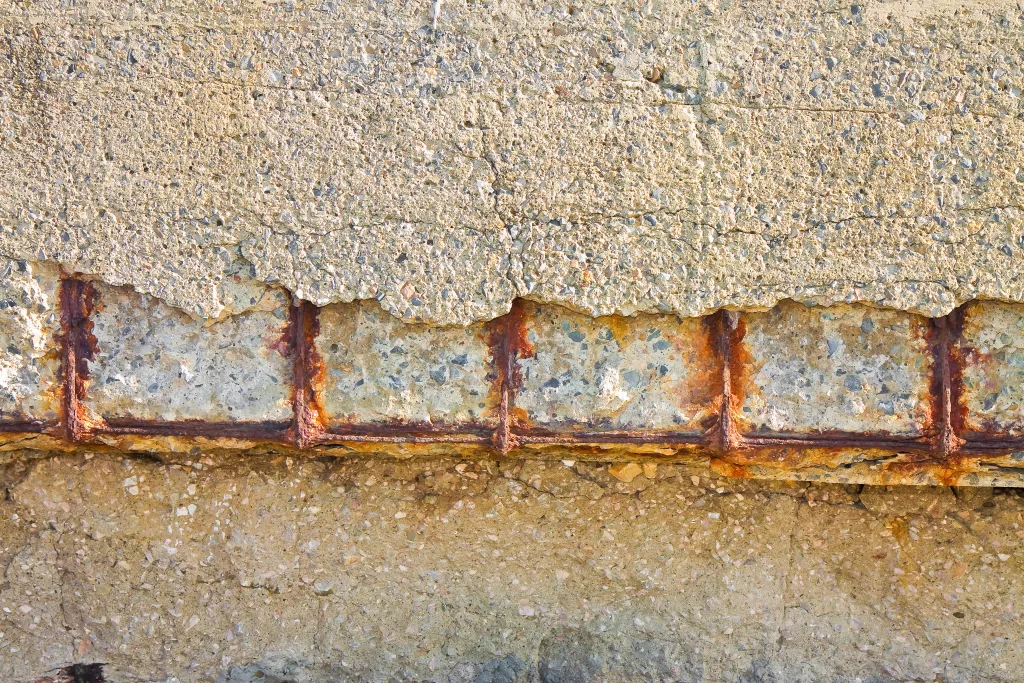Carbon fibre is a new and innovative material, while concrete is millennia-old. Why would you want to mix the two?
Concrete is a strong and durable material that can withstand an incredible amount of compression, but little tension. For this reason, concrete is very commonly reinforced with steel. Steel bars, called rebar, are placed in a variety of configurations, which are then submerged in concrete as it is poured. The resulting reinforced concrete is able to withstand tension far better, so cracks don’t form as quickly. This can prolong the life of a structure, reduce the amount of concrete that has to be used, and allow for the construction of more complex structures than would be possible without reinforcement.
Steel reinforcement introduces its own challenges. Perhaps the most important challenge is that the steel is susceptible to corrosion if it becomes exposed. When cracks develop and corrosive substances like salt and moisture reach the steel, it will corrode and lose its ability to withstand tension. The steel also expands as it corrodes, which cracks the concrete around it, further reducing the strength of the structure and exposing even more steel in a process called spalling.
A concrete structure will inevitably crack somewhat as it ages, which can require expensive remedial works to fix. This can be a particularly problematic when key infrastructure has to be shut down to undergo repairs. Carbon fibre can be used from the outset to reinforce concrete, or as a remedial measure once the structure is in place.
What types of carbon fibre reinforcement are there for concrete?
There are three main methods for reinforcing concrete with carbon fibre in the initial construction phase. The first is by adding chopped carbon fibre filament into the concrete mix, which creates a composite structure that is reinforced in almost all axes, as the fibre reinforcements are not aligned in one or two specific axes. The second way is by using carbon fibre rebar in place of steel rebar. Carbon fibre rebar cages can be used similarly to steel rebar cages. The third is with a woven carbon fibre mat that is placed into a structure before the concrete is poured.
Once a concrete structure has started to degrade, retrofitting the existing concrete with carbon fibre reinforcements can be a cost-effective way of extending the life of a structure. This can also be done when a structure is being modified during a renovation, where new loads will be added to the existing structural members. Carbon fibre can be used to do this in a variety of ways. Generally, the most effective option will depend on the area of a structure that has to be reinforced and the type of force going through the structure.
One way is to use woven carbon fibre fabrics with large gaps, which are placed against the existing concrete and covered in mortar. This reinforcement type is called textile reinforced mortar and can be particularly useful where the thermal resistance of the concrete structure has to be maintained. It can conform to complex geometries and blend in with the existing structure.
Concrete pillars can be wrapped in unidirectional fabrics and then have a resin applied, creating a carbon-fibre reinforced plastic (CFRP) sheath. This has two benefits. First, the reinforcement allows a pillar to safely withstand higher compressive forces. Second, the fabric and resin seal the pillar against the outside elements so that moisture and salts cannot penetrate the concrete and cause more spalling by corroding internal steel reinforcements.
Another way is to use carbon fibre plates to reinforce concrete beams. Plates of carbon fibre can be bonded to the surface of a concrete beam, allowing it to withstand heavier loads and sudden shocks, like earthquakes. This can be used to reinforce many horizontal spans of concrete. This can be done much faster than demolishing an existing piece of concrete and putting a new one in place.
What problems do carbon fibre reinforcements for concrete solve?
Carbon fibre solves several problems with concrete structures. When used as an integral part of a concrete structure’s design, the carbon can reinforce the concrete in any axis that the engineers choose, through the use of rebar, chopped fibres, or mats. When used as a repair, carbon fibre reinforcements can be faster, stronger, and more long-lasting than a conventional repair.
Corrosion
In marine environments, or close to bodies of water, the degradation of regular steel-reinforced concrete can be much faster than in other areas. Using carbon fibre reinforcement from the outset means that the no component in the concrete is susceptible to corrosion. When repairing a structure, concrete can be sealed against moisture and salt by using resin and carbon fibre fabric, so that no further corrosion can occur in the sealed section.
Design complexity
The superior strength and weight of carbon fibre reinforced concrete also allows for more ambitious designs for buildings, like this building with a twisting carbon concrete façade; lighter and stronger composite buildings can support themselves more easily in unconventional shapes.
Impact of repairs
Carbon fibre is a strong contender where there are particular constraints, like how long a structure would have to be shut down for in order to conduct a repair or how much space there is to work around the concrete that has to be repaired.
For critical pieces of infrastructure, only needing to shut down a structure for hours instead of days or weeks can be massively beneficial, which is the case when reinforcing with carbon fibre. External carbon fibre reinforcements can be added in a matter of hours. The surface has to be prepared by filling in any cracks, then it is just a matter of applying the reinforcement and resin and waiting for the resin to cure.
The light weight of carbon also means that when used as a repair material, the added load to the rest of the structure will be lower than using a more conventional material. For older structures that need to be repaired, this can mean that reinforcements are not needed further down to support the weight of the repair material. The weight of a new concrete reinforcement could require other parts of the structure to be reinforced to withstand the added weight. Also, where there is limited space to work, rolls of carbon fibre fabric or tape and resin can be applied by hand, so bulky equipment does not necessarily have to be used.
Earthquake resistance
By helping to absorb the energy of the movement and preventing the concrete from breaking, carbon fibre reinforcements can also increase the stability of concrete structures, making them more earthquake resistant. This can be done to improve current structures or to fix earthquake-related damage.
If you think carbon fibre could be an option in your application, please don’t hesitate to contact us at sales@sagezander.com and +44 (0)1260 295264. Our sales team are ready to help you with your enquiry.


